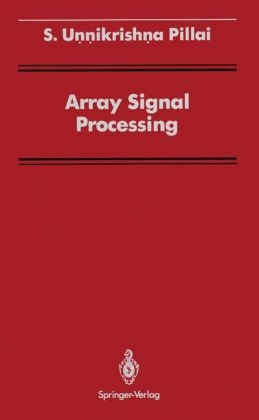
Array Signal Processing
Springer-Verlag New York Inc.
978-0-387-96951-0 (ISBN)
- Titel ist leider vergriffen;
keine Neuauflage - Artikel merken
In fact this book can be used in a one semester course following probability theory and stochastic processes.
1 Introduction.- 1.1 Introduction.- 1.2 Organization of the Book.- 1.3 Notations and Preliminaries.- 2 Detection of Multiple Signals.- 2.1 Signals and Noise.- 2.2 Conventional Techniques.- 2.2.1 Beamformer.- 2.2.2 Capon's Minimum Variance Estimator.- 2.2.3 Linear Prediction Method.- 2.3 Eigenvector-Based Techniques.- 2.3.1 Completely Coherent Case.- 2.3.2 Symmetric Array Scheme: Coherent Sources in a Correlated Scene.- 2.3.3 Spatial Smoothing Schemes: Direction Finding in a Coherent Environment.- 2.4 Augmentation and Other Techniques.- 2.4.1 Augmentation Technique.- 2.4.2 ESPRIT, TLS-ESPRIT and GEESE.- 2.4.3 Direction Finding Using First Order Statistics.- Appendix 2.A Coherent and Correlated Signal Scene.- Appendix 2.B Program Listings.- Problems.- References.- 3 Performance Analysis.- 3.1 Introduction.- 3.2 The Maximum Likelihood Estimate of the Covariance Matrix and Some Related Distributions.- 3.3 Performance Analysis of Covariance Based Eigenvector Techniques: MUSIC and Spatial Smoothing Schemes.- 3.3.1 Asymptotic Distribution of Eigenparameters Associated with Smoothed Sample Covariance Matrices.- 3.3.2 Two-Source Case - Uncorrelated and Coherent Scene.- 3.4 Performance Evaluation of GEESE Scheme.- 3.4.1 The Least Favorable Configuration (J = K).- 3.4.2 The Most Favorable Configuration (J = M - 1).- 3.5 Estimation of Number of Signals.- Appendix 3.A The Complex Wishart Distribution.- Appendix 3.B Equivalence of Eigenvectors.- Appendix 3.C Eigenparameters in a Two Source Case.- Problems.- References.- 4 Estimation of Multiple Signals.- 4.1 Introduction.- 4.2 Optimum Processing: Steady State Performance and the Wiener Solution.- 4.3 Implementation of the Wiener Solution.- 4.3.1 The Method of Steepest Descent.- 4.3.2 The Least Mean Square (LMS) Algorithm.- 4.3.3 Direct Implementation by Inversion of the Sample Covariance Matrix.- Problems.- References.
| Reihe/Serie | Signal Processing and Digital Filtering |
|---|---|
| Mitarbeit |
Stellvertretende Herausgeber: C. S. Burrus |
| Zusatzinfo | biography |
| Verlagsort | New York, NY |
| Sprache | englisch |
| Gewicht | 515 g |
| Themenwelt | Technik ► Elektrotechnik / Energietechnik |
| Technik ► Nachrichtentechnik | |
| ISBN-10 | 0-387-96951-9 / 0387969519 |
| ISBN-13 | 978-0-387-96951-0 / 9780387969510 |
| Zustand | Neuware |
| Haben Sie eine Frage zum Produkt? |
aus dem Bereich


